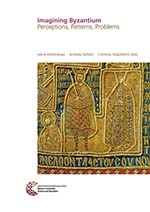News
01.02.2019
New Publication “Imagining Byzantium. Perceptions, Patterns, Problems” with articles by Christina Hadjiafxenti and Mihai-D. Grigore
 Byzantium the other. Byzantium the pompous. Byzantium the eternal. The mere existence of this empire with his rich history and otherness from western European traditions spurred the minds of scholars, noblemen, politicians and ordinary people throughout its survival and long beyond its final downfall in 1453. Neglecting its great political and cultural influence on neighbouring countries and beyond, Enlightenment writers stripped Byzantium of its original historical reality and thus created a model, which could be utilised in very different constructs, stretching from positive to absolutely negative connotations. With the rise of new nationalisms, primarily in Eastern and Southeastern Europe, and the associated politically inspired historical (re)constructions in the 19th and 20th century, the reception of Byzantium gained new facets, its perception reached into new dimensions. In this volume, we would like to shed some light on these patterns and the problems they entail, and show the different ways in which "Byzantium" was used as an argument in nation-building and in constructing new historiographical narratives, and how ist legacy endured in ecclesiastical historiography.
Byzantium the other. Byzantium the pompous. Byzantium the eternal. The mere existence of this empire with his rich history and otherness from western European traditions spurred the minds of scholars, noblemen, politicians and ordinary people throughout its survival and long beyond its final downfall in 1453. Neglecting its great political and cultural influence on neighbouring countries and beyond, Enlightenment writers stripped Byzantium of its original historical reality and thus created a model, which could be utilised in very different constructs, stretching from positive to absolutely negative connotations. With the rise of new nationalisms, primarily in Eastern and Southeastern Europe, and the associated politically inspired historical (re)constructions in the 19th and 20th century, the reception of Byzantium gained new facets, its perception reached into new dimensions. In this volume, we would like to shed some light on these patterns and the problems they entail, and show the different ways in which "Byzantium" was used as an argument in nation-building and in constructing new historiographical narratives, and how ist legacy endured in ecclesiastical historiography.
This volume represents the outcome the conference "Imagining Byzantium. Perceptions, Patterns, Problems" which was held in Mainz from 2 to 4 March 2017 and among others organized by Christina Hadjiafxenti, former IEG-Postdoc-Fellow of the Leibniz ScienceCampus Mainz: Byzantium. The Publication contains articles by Mihai-D. Grigore "Byzantium for Priests. Image of Byzantium in Romanian Theological Textbooks of the Late 20th Century" and Christina Hadjiafxenti "Byzantium in Greek Church Historiography of the 19th Century: Between German Protestant Influence and Greek Orthodox Confession".
Alena Alshanskaya, Andreas Gietzen, Christina Hadjiafxenti (eds)
Imagining Byzantium
Perceptions, Patterns, Problems
Byzanz zwischen Orient und Okzident, Band 11
2018, 132 pages
ISBN 978-3-88467- 310-2


